
The spinal cord is a bundle of nerves that carries messages between the brain and the body to control muscle movement, detect sensations, and perform other bodily functions. A spinal cord injury is any damage to the nerves in the spinal cord, (more…)
More
